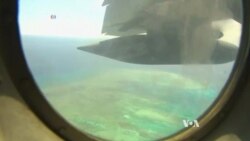U.S. officials said the Pentagon is considering sending U.S. military ships and aircraft to assert freedom of navigation in the South China Sea – a direct challenge to China, which is rapidly manufacturing artificial islands in the disputed territorial waters.
“We claim the right of innocent passage in such areas, and we exercise that right regularly, both in the South China Sea and globally,” David Shear, assistant secretary of defense for Asian and Pacific security affairs, said Wednesday at a Senate hearing. “We’re going to continue exercising that right, both on the surface of the waters and in the air.”
Pentagon spokesman Colonel Steve Warren said Wednesday that the “key point” is that the waterways and air above the disputed Spratly Islands are international. He said the U.S. Navy “routinely” conducts maritime patrols in the area.
“International law does not recognize man-made islands as an extension of the mainland, and in this case, nor do we,” Warren said.
Chinese piers, helipads
Images from Google Earth have documented, since President Xi Jinping took office in 2012, China’s work on four reefs in waters where Beijing’s territorial claims overlap with those of its neighbors. The work has included such structures as piers and helipads.
U.S. State Department officials have repeatedly asked China to stop the construction.
“No matter how much sand you pile on a reef in the South China Sea, you can’t manufacture sovereignty,” Daniel Russel, assistant secretary of state for East Asian and Pacific affairs, said in written testimony to the Senate Foreign Relations Committee. He told the committee that a U.S. presence is needed in the region to ensure everyone with a stake in the sea follows international law.
“Our strategy and our actions are designed to protect rules, not to protect rocks,” he said Wednesday.
The area is one of the world’s busiest shipping routes, so U.S. interests would be directly affected if China were to enforce control over the sea.
Russel told lawmakers Wednesday that the U.S. must use “all instruments of national power” to “push back” on what he called “problematic behavior.”
He added that the South China Sea dispute would be a topic of discussion when U.S. Secretary of State John Kerry visits China late this week.
Is US response sufficient?
Shear testified that at the current rate, the Chinese will complete construction of an airfield on one of the reefs in 2017 or 2018.
Lawmakers expressed concern that U.S. efforts to deter China from building structures that could be used to enforce control of the sea might be too little, too late.
But Shear assured lawmakers the U.S. would continue to “maintain military superiority in the region” through the deployment of F-35 aircraft and V-22 Ospreys to the region. He also said the U.S. would send four new combat ships to Singapore by 2020 and an additional U.S. submarine to Guam.
“We’ll have no shortage of capabilities and assets throughout the region to back our diplomacy, ensure deterrence and ensure national security,” Shear said.
On Tuesday, the Reuters news agency and The Wall Street Journal cited an official who said Secretary of Defense Ashton Carter had requested options that included sending U.S. ships and aircraft within 22 kilometers (almost 14 miles) of the reefs that China has been building upon.
China's Foreign Ministry said Wednesday that it was "extremely concerned" about the reported Pentagon plan and had asked the U.S. to clarify the remarks.










